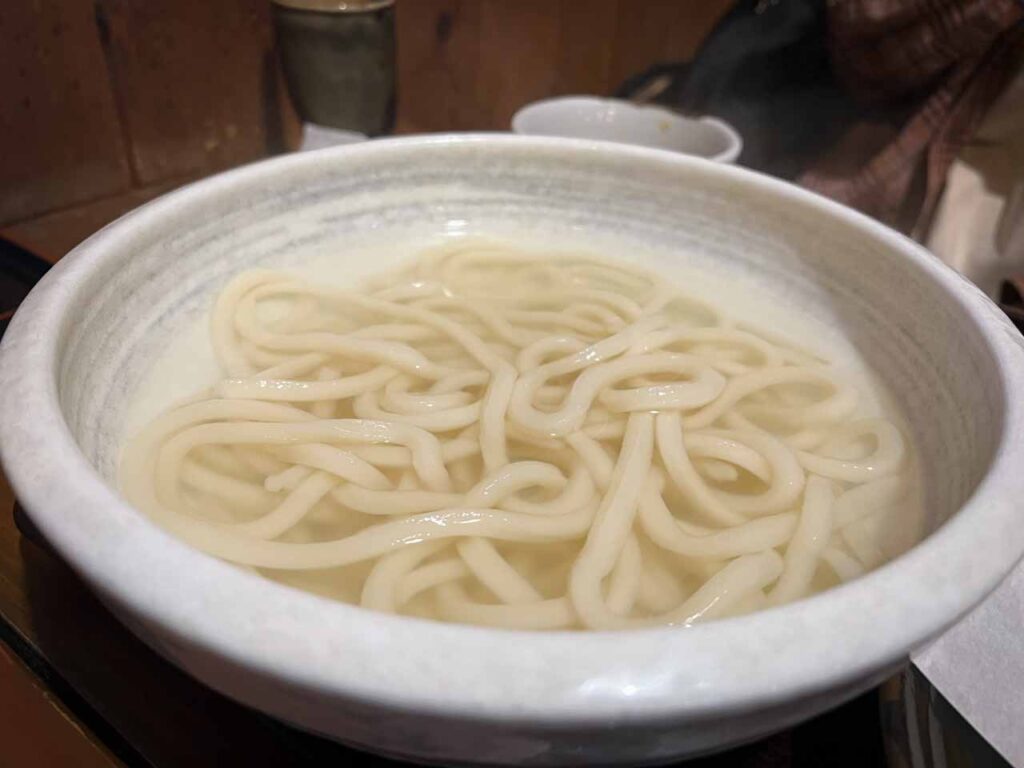In the diverse world of Japanese noodles, Kama-age Udon stands out as one of the most comforting and authentic ways to experience the artistry of Sanuki udon. With its warm, silky noodles served directly from the cooking pot, this humble preparation offers a window into Japan’s culinary history and philosophy of simplicity.
The Origins of Kama-age Udon: A Dish Born in Sanuki
Kama-age Udon (釜揚げうどん) literally means “pot-pulled udon.” The name reflects its preparation: freshly boiled noodles served directly from the pot (kama) without being rinsed in cold water, allowing diners to enjoy their full warmth, aroma, and natural flavor.
The roots of Kama-age Udon stretch back to Japan’s Edo period (1603–1868), specifically in the Sanuki region — modern-day Kagawa Prefecture, now known as Japan’s udon capital. During this era, wheat cultivation flourished in Sanuki’s favorable climate, and udon became a daily staple for the local population. Preparing large batches of noodles in communal pots allowed families and workers to eat quickly and efficiently, making kama-age udon both practical and deeply ingrained in local food culture.
What Makes Kama-age Udon Unique?
Unlike many other udon styles that are rinsed and cooled after boiling, kama-age udon is served immediately after cooking, preserving the noodles’ natural heat, moisture, and slightly cloudy starch-infused broth.
Here’s what sets it apart:
- Texture: The boiling process gelatinizes the starch on the noodle surface, creating a uniquely smooth, slightly slippery texture while maintaining the signature firm and chewy Sanuki bite.
- Temperature: Served piping hot, kama-age udon delivers a comforting warmth that’s perfect for chilly days or as a satisfying, soul-soothing meal any time of year.
- Flavor: Without rinsing, the natural wheat aroma and flavor are fully retained, allowing the purity of the ingredients to shine.
The Art of Serving Kama-age Udon
Part of the charm of kama-age udon lies in its simple, interactive serving style:
- The noodles are boiled in a large pot and served directly in hot water, often in a wooden bowl that helps maintain heat.
- Diners receive individual dipping bowls filled with a warm, concentrated dipping sauce known as tsuyu, typically made from soy sauce, dashi (bonito and kelp broth), and mirin.
- Toppings such as chopped green onions, grated ginger, sesame seeds, or tempura crumbs (tenkasu) are added to the dipping sauce for extra flavor and texture.
- The noodles are dipped bite by bite into the seasoned tsuyu, allowing full control over the balance of flavors with each mouthful.
This hands-on approach not only enhances the enjoyment of the meal but also reflects the Japanese appreciation for mindful eating.
Explore Kama-age Udon ingredients on Amazon
Kama-age Udon vs. Cold Water-Rinsed Udon
A key distinction in Japanese udon culture is between kama-age udon and water-rinsed udon (known as hiyashi udon or zaru udon):
| Feature | Kama-age Udon | Water-Rinsed Udon |
|---|---|---|
| Preparation | Served directly in hot water | Rinsed in cold water after boiling |
| Texture | Soft, chewy, silky | Firm, springy, refreshing |
| Flavor | Full wheat aroma, rich mouthfeel | Clean, light, ideal for summer |
| Seasonality | Popular year-round | Popular in hot weather |
Both styles showcase the versatility of Sanuki udon, but kama-age’s warm presentation makes it especially comforting.
Why Serve Udon in Hot Water?
Keeping the noodles in their hot cooking water serves multiple purposes:
- Heat retention: Prevents the noodles from cooling too quickly, preserving their optimal temperature.
- Moisture preservation: Maintains the soft-yet-chewy texture that defines Sanuki udon.
- Flavor concentration: As the starch slowly dissolves into the water, it subtly thickens the broth, adding body and richness to each bite.
This simple method reflects the Japanese culinary philosophy of maximizing natural flavors with minimal interference.
Nutritional Benefits of Kama-age Udon
Beyond its comforting taste, kama-age udon offers a well-balanced nutritional profile:
- Carbohydrates: The wheat flour base provides a rich source of energy, making it ideal for active lifestyles.
- Protein: While moderate, udon’s protein supports muscle maintenance and overall health.
- Dietary fiber: Contributes to healthy digestion and regularity.
- Low fat content: Compared to many Western comfort foods, kama-age udon is naturally low in fat, making it a lighter option.
Of course, nutritional value can be further enhanced with protein-rich toppings like tempura shrimp, soft-boiled eggs, or tofu.
Cultural Significance of Kama-age Udon
In Kagawa Prefecture, kama-age udon remains a beloved everyday meal, often enjoyed at family-run udon shops where noodles are made fresh each morning. These simple establishments, known as self-service udon shops, allow customers to select their portions, add toppings, and customize their dipping sauces — offering an approachable introduction to Japanese food culture for travelers.
Eating kama-age udon is not just a meal but an experience that reflects Japanese craftsmanship, seasonality, and respect for simple ingredients.
Summary
Kama-age Udon is a timeless expression of Japanese culinary simplicity — fresh Sanuki noodles boiled and served straight from the pot, accompanied by flavorful dipping sauce and traditional toppings. Its warm, silky texture and robust wheat flavor offer comfort and satisfaction in every bite. Whether enjoyed in a humble udon shop in Kagawa or recreated at home, kama-age udon provides a delicious glimpse into Japan’s rich noodle tradition.


